Readings Newsletter
Become a Readings Member to make your shopping experience even easier.
Sign in or sign up for free!
You’re not far away from qualifying for FREE standard shipping within Australia
You’ve qualified for FREE standard shipping within Australia
The cart is loading…






This title is printed to order. This book may have been self-published. If so, we cannot guarantee the quality of the content. In the main most books will have gone through the editing process however some may not. We therefore suggest that you be aware of this before ordering this book. If in doubt check either the author or publisher’s details as we are unable to accept any returns unless they are faulty. Please contact us if you have any questions.
While currently available texts dealing with the subject of high perfor mance composite materials touch upon a spectra of topics such as mechanical metallurgy, physical metallurgy, micromechanics and macro mechanics of such systems, it is the specific purpose of this text to examine elements of the mechanics of structural components composed of composite materials. This text is intended for use in training engineers in this new technology and rational thought processes necessary to develop a better understanding of the behavior of such material systems for use as structural components. The concepts are further exploited in terms of the structural format and development to which the book is dedicated. To this end the development progresses systematically by first introducing the notion and concepts of what these new material classes are, the fabrication processes involved and their unique features relative to conventional monolithic materials. Such introductory remarks, while far too short in texts of this type, appear necessary as a precursor for engineers to develop a better understanding for design purposes of both the threshold limits to which the properties of such systems can be pushed as well as the practical limitations on their manufacture. Following these introductory remarks, an in-depth discussion of the important differences between composites and conventional monolithic material types is discussed in terms of developing the concepts associated with directional material properties.
$9.00 standard shipping within Australia
FREE standard shipping within Australia for orders over $100.00
Express & International shipping calculated at checkout
This title is printed to order. This book may have been self-published. If so, we cannot guarantee the quality of the content. In the main most books will have gone through the editing process however some may not. We therefore suggest that you be aware of this before ordering this book. If in doubt check either the author or publisher’s details as we are unable to accept any returns unless they are faulty. Please contact us if you have any questions.
While currently available texts dealing with the subject of high perfor mance composite materials touch upon a spectra of topics such as mechanical metallurgy, physical metallurgy, micromechanics and macro mechanics of such systems, it is the specific purpose of this text to examine elements of the mechanics of structural components composed of composite materials. This text is intended for use in training engineers in this new technology and rational thought processes necessary to develop a better understanding of the behavior of such material systems for use as structural components. The concepts are further exploited in terms of the structural format and development to which the book is dedicated. To this end the development progresses systematically by first introducing the notion and concepts of what these new material classes are, the fabrication processes involved and their unique features relative to conventional monolithic materials. Such introductory remarks, while far too short in texts of this type, appear necessary as a precursor for engineers to develop a better understanding for design purposes of both the threshold limits to which the properties of such systems can be pushed as well as the practical limitations on their manufacture. Following these introductory remarks, an in-depth discussion of the important differences between composites and conventional monolithic material types is discussed in terms of developing the concepts associated with directional material properties.